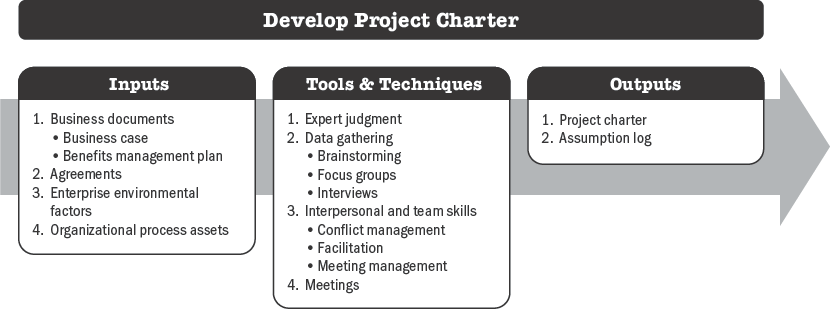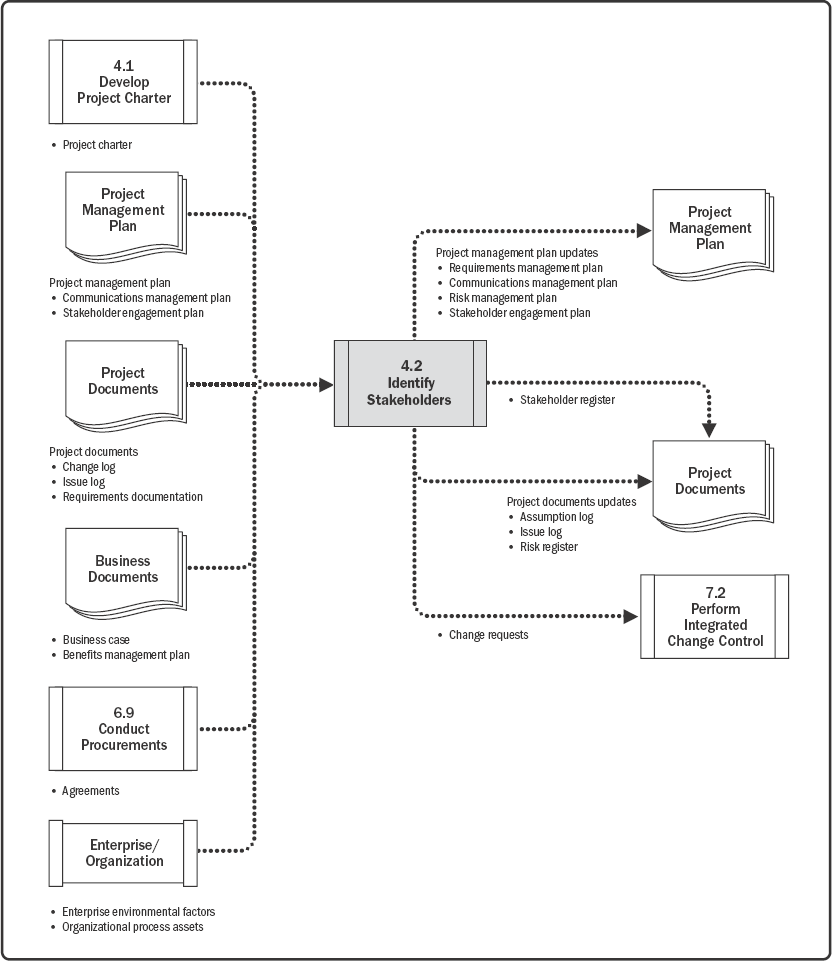4
Initiating Process Group
The processes in the Initiating Process Group are shown in Table 4-1.
Table 4-1. Initiating Process Group Processes

These processes define a new project or a new phase of an existing project by obtaining authorization to start the project or phase. The purpose of this Process Group is to align stakeholder expectations and the project purpose, inform stakeholders of the scope and objectives, and discuss how their participation in the project and its associated phases can help to ensure their expectations are met. The initial scope is defined and initial financial resources are committed. Stakeholders who will interact and influence the overall outcome of the project are identified. The project manager is appointed if not already assigned. This information is captured in the project charter and stakeholder register. When the project charter is approved, the project is officially authorized, and the project manager is authorized to apply organizational resources to the project activities.
The key benefits of this Process Group are that only projects that are aligned with the organization's strategic objectives are authorized and the business case, benefits, and stakeholders are considered from the start of the project. In some organizations, the project manager is involved in developing the business case and defining the benefits. In those organizations, the project manager generally helps write the project charter; in other organizations, the pre-project work is done by the project sponsor, project management office (PMO), portfolio steering committee, or other stakeholder group. This practice guide assumes the project has been approved by the sponsor or other governing body and the business documents have been reviewed prior to authorizing the project. In most cases, business documents originate outside of the project, but are used as inputs to the project.
Business documents are documents that are generally originated outside of the project but are used as inputs to the project. Examples of business documents include the business case and benefits management plan. Figure 4-1 shows the sponsor and the business documents in relation to the Initiating Processes.

Figure 4-1. Project Boundaries
Projects are often divided into phases. When this is done, information from processes in the Initiating Process Group is reexamined to determine if the information is still valid. Revisiting the Initiating processes at the start of each phase helps keep the project focused on the business need that the project was undertaken to address. The project charter, business documents, and success criteria are verified. The influence drivers, expectations, and objectives of the project stakeholders are reviewed.
4.1 DEVELOP PROJECT CHARTER
Develop Project Charter is the process for developing the document that formally authorizes the existence of a project and provides the project manager with the authority to apply organizational resources to project activities. The key benefits of this process are:
▶Provides a direct link between the project and the strategic objectives of the organization,
▶Creates a formal record of the project, and
▶Shows the organizational commitment to the project.
This process is performed once or at predefined points in the project. The inputs, tools and techniques, and outputs are shown in Figure 4-2. Figure 4-3 presents the data flow diagram for this process.

Note: This figure provides the inputs, tools and techniques, and outputs that may be used for this process. Descriptions for inputs and outputs appear in Section 9. Descriptions for tools and techniques appear in Section 10.
Figure 4-2. Develop Project Charter: Inputs, Tools & Techniques, and Outputs

Note: This figure provides the inputs and outputs that may be used for this process. Descriptions for inputs and outputs appear in Section 9.
Figure 4-3. Develop Project Charter: Data Flow Diagram
The project charter establishes a partnership between the performing and requesting organizations. In the case of external projects, a formal contract is typically the preferred way to establish an agreement. A project charter may still be used to establish internal agreements within an organization to ensure proper delivery under the contract. The approved project charter formally initiates the project. A project manager is identified and assigned as early in the project as is feasible, preferably while the project charter is being developed and always prior to the start of planning. The project charter can be developed by the sponsor or the project manager in collaboration with the initiating entity. This collaboration allows the project manager to have a better understanding of the project purpose, objectives, and expected benefits. This understanding will better allow for efficient resource allocation to project activities. The project charter provides the project manager with the authority to plan, execute, and control the project.
Projects are initiated by an entity external to the project such as a sponsor, program, or project management office (PMO), or a portfolio governing body chairperson or authorized representative. The project initiator or sponsor should be at a level that is appropriate to procure funding and commit resources to the project. Projects are initiated due to internal business needs or external influences. These needs or influences often trigger the creation of a needs analysis, feasibility study, business case, or description of the situation that the project will address. Chartering a project validates alignment of the project to the strategy and ongoing work of the organization. A project charter is not considered to be a contract because there is no consideration or money promised or exchanged in its creation.
4.2 IDENTIFY STAKEHOLDERS
Identify Stakeholders is the process of identifying project stakeholders regularly and analyzing and documenting relevant information regarding their interests, involvement, interdependencies, influence, and potential impact on project success. The key benefit of this process is that it enables the project team to identify the appropriate focus for engagement of each stakeholder or group of stakeholders.
This process is performed periodically throughout the project as needed. The inputs, tools and techniques, and outputs are shown in Figure 4-4. Figure 4-5 presents the data flow diagram for this process.

Note: This figure provides the inputs, tools and techniques, and outputs that may be used for this process. Descriptions for inputs and outputs appear in Section 9. Descriptions for tools and techniques appear in Section 10.
Figure 4-4. Identify Stakeholders: Inputs, Tools & Techniques, and Outputs

Note: This figure provides the inputs and outputs that may be used for this process. Descriptions for inputs and outputs appear in Section 9.
Figure 4-5. Identify Stakeholders: Data Flow Diagram
This process frequently occurs for the first time in a project either prior to or at the same time the project charter is developed and approved. It is repeated as necessary but should be performed at the start of each phase and when a significant change in the project or the organization occurs. Each time the identification process is repeated, the project management plan components and project documents should be consulted to identify relevant project stakeholders.
